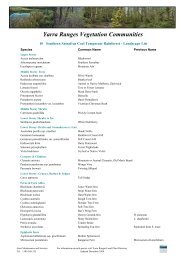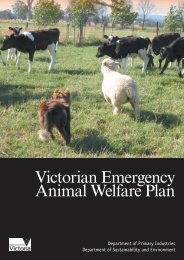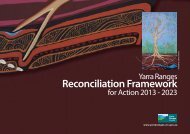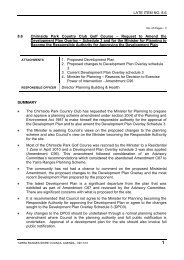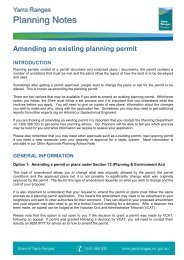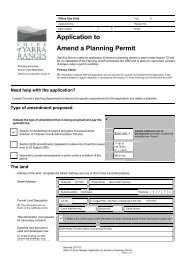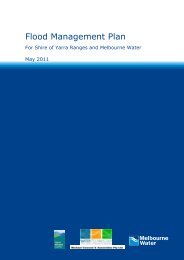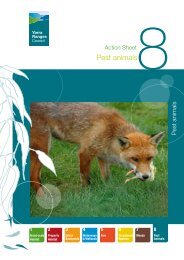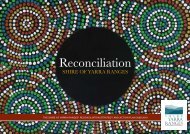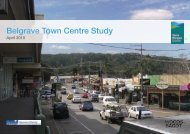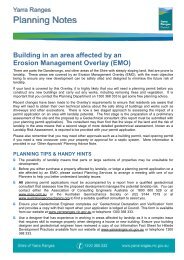Landscape Guidelines - Shire of Yarra Ranges
Landscape Guidelines - Shire of Yarra Ranges
Landscape Guidelines - Shire of Yarra Ranges
- No tags were found...
You also want an ePaper? Increase the reach of your titles
YUMPU automatically turns print PDFs into web optimized ePapers that Google loves.
<strong>Landscape</strong><strong>Guidelines</strong>How to prepare a <strong>Landscape</strong> Planin the <strong>Shire</strong> <strong>of</strong> <strong>Yarra</strong> <strong>Ranges</strong>
2 <strong>Landscape</strong> <strong>Guidelines</strong>ContentsIntroduction 1Step AWhat zone is your property in? 3Step BKey principles to consider in your <strong>Landscape</strong> Plan 5- Sustainable purchasing 3- Biodiversity protection and enhancement 3- Water conservation 3- Energy conservation 3- Wildfire management 4Step CWhat must be in your <strong>Landscape</strong> Plan 7- Document information 7- Information about existing conditions onthe property 7- Design justification 7- <strong>Landscape</strong> Plan drawing 8- Plant Schedule 8- Plant and tree protection 12- Soil preparation 13- Planting techniques 13- Mulch type and depth 15- Lawn treatment 15- Garden bed and lawn edge treatments 17- Irrigation 18- Maintenance program 19An example <strong>of</strong> a <strong>Landscape</strong> Plan drawing 20Additional resources 22Photo credits:Cover: Main photo: Juvenile King Parrot (Emma Campbell), Golden TipGoodia lotifolia (Colleen Miller), Old Man’s Beard Austral clematis (David Blair).Contents page: Chocolate Lily Arthropodium strictum (Marty White), CrimsonRosella eating Dianella flowers (Emma Campbell).<strong>Landscape</strong> <strong>Guidelines</strong>purpose & scopeThese <strong>Landscape</strong> <strong>Guidelines</strong> are aimedat landscape designers and peoplewho are applying for a planning permit.The guidelines will help you to develop<strong>Landscape</strong> Plans that are consistentwith the <strong>Shire</strong> <strong>of</strong> <strong>Yarra</strong> <strong>Ranges</strong>’ currentpolicies, strategies and programs aimed atprotecting our natural environment. Use <strong>of</strong>these guidelines will help ensure that yourplanning application is processed efficiently.These guidelines outline the key “s<strong>of</strong>tlandscaping” design aspects thatshould be taken into consideration inall developments, including residential,medium density housing, industrial, retailand commercial developments, that requirea <strong>Landscape</strong> Plan as part <strong>of</strong> a planningapplication.These <strong>Landscape</strong> <strong>Guidelines</strong> shouldbe used in conjunction with the followingdocuments when developing a<strong>Landscape</strong> Plan::: Environmental Weeds withinthe <strong>Shire</strong> <strong>of</strong> <strong>Yarra</strong> <strong>Ranges</strong>www.yarraranges.vic.gov.au/Files/List_<strong>of</strong>_Environmental_Weeds.pdf:: <strong>Yarra</strong> <strong>Ranges</strong> Local PlantDirectorywww.yarraranges.vic.gov.au/plants
<strong>Landscape</strong> <strong>Guidelines</strong> 1Native violet Viola hederacea(Caroline Carvalho)IntroductionThe <strong>Shire</strong> <strong>of</strong> <strong>Yarra</strong> <strong>Ranges</strong> region is recognised as one <strong>of</strong> the mostbeautiful natural landscapes in Victoria. It makes up 51% <strong>of</strong> the <strong>Yarra</strong>Catchment and hosts some <strong>of</strong> the most significant biodiversity assets <strong>of</strong>the State including habitat for the two endangered state faunal emblems- the Leadbeater’s Possum and the Helmeted Honeyeater, and the Statefloral emblem - the Common Heath. The region’s forests are home to thetallest flowering plant in the world – the Mountain Ash. The <strong>Shire</strong>’s naturalecosystems draw tourists to the area, making it a popular place forrecreation and enjoyment <strong>of</strong> the scenic beauty.It is for these environmental, social and eco-tourism values that the <strong>Shire</strong><strong>of</strong> <strong>Yarra</strong> <strong>Ranges</strong> has a range <strong>of</strong> policies, strategies, the Planning Schemeand supportive <strong>Guidelines</strong> to assist in the responsible management andpreservation <strong>of</strong> the valued natural assets unique to this region.Vision 2020Vision 2020 is a shared vision <strong>of</strong> the <strong>Shire</strong> <strong>of</strong> <strong>Yarra</strong> <strong>Ranges</strong>, developed in consultation with thecommunity, to make a statement <strong>of</strong> what kind <strong>of</strong> community and environment we wish for inthe future. It is a steering document that guides all departments <strong>of</strong> the council.Under the Environmental Stewardship Theme, Vision 2020 sees the <strong>Shire</strong> protecting andenhancing the biodiversity values <strong>of</strong> our area through linking vegetation corridors, restoringindigenous vegetation and natural waterways and controlling the spread <strong>of</strong> environmentalweeds. Through the strategic guidance <strong>of</strong> the <strong>Shire</strong>’s Environment Strategy (2009) and issuespecific sub-strategies the <strong>Shire</strong> is working to achieve this vision.
2 <strong>Landscape</strong> <strong>Guidelines</strong>Common Correa Correa reflexa(Marty White)Vegetation protection inthe <strong>Shire</strong> <strong>of</strong> <strong>Yarra</strong> <strong>Ranges</strong>General vegetation protectionThe protection <strong>of</strong> native vegetation is a highpriority in the <strong>Shire</strong> <strong>of</strong> <strong>Yarra</strong> <strong>Ranges</strong>. UnderLocal Provisions 22.12 in the <strong>Shire</strong> <strong>of</strong> <strong>Yarra</strong><strong>Ranges</strong> (SYR) Planning Scheme, vegetationis protected from destruction on both publicand private land areas. Any plant that occursnaturally (i.e. is indigenous to an area), whetherit is a small grass tussock, an orchid, wildfloweror the tallest tree, is protected and requires apermit to be removed or lopped. A permit isalso required to remove, destroy or lop anynative (Australian but not locally native) andintroduced plant species greater than fivemetres in height. Doing so without a permitmay be a breach <strong>of</strong> the law. Some exceptionsdo exist in relation to vegetation removal.Contact with the <strong>Shire</strong>’s Planning ServicesDepartment (1300 368 333) should be madeprior to any actions being undertaken.Vegetation on <strong>Shire</strong>-owned landVegetation, including dead trees, cannot beremoved or lopped on <strong>Shire</strong>-owned land suchas roadside reserves and footpath verges.without written approval from the <strong>Shire</strong>. Deadtrees provide important habitat for native faunaand are an essential part <strong>of</strong> wildlife corridors.Contact the <strong>Shire</strong>’s Arborists Team (1300 368300) for exemptions in relation to DangerousTree Assessments. This is a fee-for-serviceassessment conducted by qualified arborists.Remnant indigenous vegetationRemnant vegetation (indigenous vegetationthat grows in the area naturally and has notbeen planted) is sensitive to disturbancethrough indiscriminate and incrementalclearing which can result in the intrusion <strong>of</strong>environmental weeds and the loss <strong>of</strong> habitatfor plants and animals.In relation to the re-establishment orrestoration <strong>of</strong> indigenous vegetation, thePlanning Scheme states:“In any landscaping or replanting requirementsimposed under this planning scheme,preference be given to planting native specieswhich are indigenous to the area within whichthey are to be planted, and which are suitablefor the location and purpose sought for thereplanting. These plantings should not includespecies that are listed as environmental weedsin this local planning policy”. (Clause 22.12-6)Victorian Native Vegetation ManagementFramework (NVMF)In addition to the <strong>Shire</strong>’s Planning Schemezoning and overlays, the NVMF is a VictorianGovernment policy incorporated into theVictorian Planning Provisions. The “NativeVegetation Management: a Frameworkfor Action” aims to achieve a “net-gain” –an increase in native vegetation - acrossthe State whenever there are planneddisturbances <strong>of</strong> native vegetation. The<strong>Shire</strong> <strong>of</strong> <strong>Yarra</strong> <strong>Ranges</strong> needs to ensure alldevelopments that include vegetation removalcomply with this State policy and have therequired “<strong>of</strong>fsets” (to replace native vegetationor enhance remaining vegetation) can be metto ensure a net-gain is achieved.Developments that require a large amount<strong>of</strong> vegetation removal, or that proposeremoval <strong>of</strong> rare or threatened plant speciesmay be required to employ a qualified LandManagement Consultant to develop a ‘LandManagement Plan’ including a ‘habitathectare’ vegetation quality assessment tocomply with the NVMF.
<strong>Landscape</strong> <strong>Guidelines</strong> 3Preparing a <strong>Landscape</strong> PlanStep A:What zone is yourproperty in?The <strong>Shire</strong> <strong>of</strong> <strong>Yarra</strong> <strong>Ranges</strong> (SYR) has adopted a series <strong>of</strong> rural zones and overlays from theVictorian Planning Provisions that acknowledge the values <strong>of</strong> certain classifications <strong>of</strong> rural landand their associated environmental significance. The zone and associated overlays that apply toa property will influence how that land is allowed to be used, making it important to understandthese limitations before you start planning your development.How to find what zone your property is in:: Contact the SYR ‘Community Links’ <strong>of</strong>fice 1300 368 333 or visit them at thefollowing locations:Lilydale – corner <strong>of</strong> Anderson & Hardy StreetsHealesville – 276 Maroondah HwyMonbulk – 94 Main StreetUpwey – 40 Main Street<strong>Yarra</strong> Junction – corner <strong>of</strong> Warburton Hwy & Hoddle Street:: Search for your property athttp://services.land.vic.gov.au/landchannel/content/addressSearch:: Search the SYR Planning Scheme online:www.dse.vic.gov.au/planningschemes/yarraranges/home.html
4 <strong>Landscape</strong> <strong>Guidelines</strong>A basic outline <strong>of</strong> rural zones and overlaysRural Conservation Zone (RCZ)Land classified RCZ is the most protected against use or development that isconsidered environmentally unsustainable. Generally RCZ land has a high degree <strong>of</strong>remnant vegetation and is located in an area <strong>of</strong> continuous indigenous vegetation.Green Wedge Zone (GWZ)GWZ land is the interface between urban fringes and rural land. This zoningis designed to maintain areas for agriculture and horticulture to continue in anenvironmentally sustainable manner.Environmental Significance Overlay (ESO)ESOs identify areas where the development <strong>of</strong> the land may be affected byenvironmental constraints and to ensure the development is compatible withidentified environmental values. The <strong>Shire</strong> <strong>of</strong> <strong>Yarra</strong> <strong>Ranges</strong> has 75 sites <strong>of</strong> BotanicalSignificance and 39 sites <strong>of</strong> Zoological Significance identified in ESO - Schedule1 <strong>of</strong> the Planning Scheme. Development on or around these sites will requireincreased environmental sensitivity.Wildfire Management Overlay (WMO)A WMO is applied to rural properties that carry a reasonable risk <strong>of</strong> bushfire due tothe density and type <strong>of</strong> vegetation. Developments that are planned on propertieswith a WMO will have to carefully consider wildfire prevention along with therequirement to protect biodiversity. Some developments will require a ‘WildfireManagement Plan’ to be designed by a qualified Land Management Consultant.Snowy Daisy Bush Olearia Iirata(Marty White) King Parrot (EmmaCampbell)Erosion Management Overlay (EMO)An EMO is used to protect areas prone to erosion, landslip or other landdegradation processes, by minimising land disturbance and inappropriatedevelopment. Land with an EMO will have limitations on the type <strong>of</strong> developmentallowed including limitations on soil removal and movement.
<strong>Landscape</strong> <strong>Guidelines</strong> 5Step B:Key principlesto consider in your<strong>Landscape</strong> PlanSustainable purchasingCouncil is committed to the principles <strong>of</strong>sustainability. <strong>Landscape</strong> designs need toincorporate environmental sustainability by::: Using materials produced from renewableresources for mulch, garden sleepers,decking materials, and stone, recycledbrick or recycled concrete:: Using materials that are locally sourced thatcontribute to the betterment <strong>of</strong> the localeconomy and reduce high transportationcosts and emission impacts on theenvironment:: Selecting plants and built featuresthat conserve water and treat/re-usewastewater and stormwater run<strong>of</strong>fWater conservationWith water resources increasingly limited, allgarden designs must incorporate efforts toreduce demand for potable water for nondrinkingpurposes, and to improve the quality<strong>of</strong> water before it enters waterways.These include but are not limited to::: Keeping lawn areas to a minimum - considerporous paving, ground cover plants:: Incorporating greywater/stormwaterirrigation:: Selecting and grouping plants accordingto their water needs:: Use <strong>of</strong> sustainable mulch to a minimum <strong>of</strong>75mm depth to minimise evaporationBiodiversity protection& enhancementIn order to protect and enhanceremnant indigenous vegetation, landscapedesigns must::: Identify and protect any existing remnantindigenous vegetation:: Identify and remove environmental weeds:: Establish gardens using local indigenousplant species:: Recognise that native animals will beattracted to and flourish in indigenousgardens:: Where required, plan for wildfiremanagement while protecting biodiversityvaluesEnergy conservationReducing the energy requirements in theestablishment and on-going maintenance <strong>of</strong>a landscape is most effective if done at theplanning stage.Common EverlastingChrysocephalum apiculatum(<strong>Shire</strong> <strong>of</strong> <strong>Yarra</strong> <strong>Ranges</strong>)
6 <strong>Landscape</strong> <strong>Guidelines</strong>Energy requirements come in many forms::: Human labour to mow lawns, waterplants, apply fertilisers and herbicides.:: Petrol to run mowers and whippersnippers:: Electricity to run pond pumps, lightingand electric mowers:: Energy costs involved in producing andusing herbicides or fertiliser:: Transport <strong>of</strong> garden products over longdistancesWildfire managementIf your property is located in a potentialbushfire area you will need to appropriatelymanage the vegetation around your home.Proper planning in the design phase canprovide the appropriate mix <strong>of</strong> elementsrequired to save your house while protectingthe biodiversity values <strong>of</strong> your property.:: Design vegetation breaks around yourhouse to slow the spread and speed <strong>of</strong>the fire and reduce radiant heat:: Remove existing weeds and do notintroduce new ones into the garden asweeds <strong>of</strong>ten contribute to high fuel loadsthat feed firesLeft to right:Tasman Flax-lilyDianella tasmanicaKnobby Club RushFicinia nodosa(Caroline Carvalho)Tips to reduce energy requirements::: Keep lawn areas to a minimum – theyrequire a lot <strong>of</strong> energy (fertilisers, mowing)in their establishment and continualmaintenance:: Use grass seed, not instant turf, toestablish lawns (see below):: Use locally available products to reducetransport energy costs and to keep withthe local character (avoid river pebblesharvested from Asia, or Merbau timberdecking from Indonesian rainforests):: Avoid plants that are vigorous growers or“weedy”, as these will require on-goingcontrol requiring human labour, mowingand herbicides:: Plant selection and placement shouldcontribute to solar efficiency <strong>of</strong> buildingsby providing shade in the summer andallowing sun through in the winter:: Don’t rely on plants being ‘fire-retardant’– all plants can burn in high intensity fires:: Avoid having plants near your home thatmay burn more easily. Such plants includethose that accumulate lots <strong>of</strong> dry or deaddebris during the fire season, have loose,flaky bark, have masses <strong>of</strong> very fine leavesor have very low moisture content:: Do not plant large shrubs and trees tooclose to buildings (within 2m) where theycan drop a limb or bring the fire over thebuilding:: Consider the building location in relationto prevailing summer winds, as thisindicates the most likely direction abushfire may come from:: Ensure good access to water forfirefighting:: Graded or ploughed breaks canencourage weeds and cause soil erosionso consider other ways <strong>of</strong> creating lowfuelareas, such as grazing, paving orslashingFurther reading‘<strong>Landscape</strong> and Building Design for Bushfire Areas’, CairdRamsay and Lisle Rudolph, CSIRO Publishing, 2003.
<strong>Landscape</strong> <strong>Guidelines</strong> 7Step C:What must be in your<strong>Landscape</strong> PlanWhen developing your <strong>Landscape</strong> Plan we recommend you use the accompanying <strong>Landscape</strong>Plan Applicant Checklist to ensure you include all the required elements in your plan. Below is asummary <strong>of</strong> the elements you should include.1. Document informationPlease use a standard scale <strong>of</strong> 1:100 or 1:200to allow the plan to be legible when printed onA4 or A3 sized paper. Larger developmentsmay submit larger sized plans if necessary.All plans must be black and white only;colour detail will not get reproduced. If colourplans are necessary ensure that at least fivecopies are supplied to the Council with yourapplication.Include the planning permit number suppliedby the SYR Planning Services Department.2. Information about existingconditions on the propertyInclude on the landscape plan drawing or inan attached document::: Property statutory requirements: the zoneand any overlays or ‘173 Agreements’attached to the property:: Descriptions <strong>of</strong> neighbourhoodcharacter, including nature strips,remnant vegetation, weeds, roadsides,footpaths and parks or reserves. For smalldevelopments “neighbourhood” generallymeans neighbouring properties; for largerdevelopments streets, blocks and suburbsshould be considered3. Design justificationInclude in your <strong>Landscape</strong> Plan, or in anattached document::: The objectives <strong>of</strong> your landscapedesign. Objectives could include visualscreening, buffers, traffic control,biodiversity protection and enhancement,or solar access:: Neighbourhood character: How will theproposed development fit in with theneighbourhood character? What is thehousing density, how is the land used?:: Topography, soil type: contours, slopedirection, drainage- plan solar access for building andgarden placement to make the most<strong>of</strong> solar energy- Is the soil sandy or clay? This willdetermine suitable plant choices:: Linkages to public open space orbushland- Is the site close to existing parks orbushland that will have an impacton the appropriate design <strong>of</strong> thedevelopment?:: Height and type <strong>of</strong> existing fencing:: Height and location <strong>of</strong> adjoining buildings
8 <strong>Landscape</strong> <strong>Guidelines</strong>4. <strong>Landscape</strong> Plan drawingA landscape drawing should graphicallyrepresent the areas to be occupied by builtstructures, as well as showing the placement<strong>of</strong> vegetation to be removed or planted. Thiswill allow the council to more accuratelydetermine the appropriateness <strong>of</strong> the changesto existing vegetation and the objectives <strong>of</strong>new plantings. While the landscape drawingis best prepared by a pr<strong>of</strong>essional, it can bedone by anyone as long as all the requiredelements are included.any areas <strong>of</strong> cut and fill, and the location <strong>of</strong>underground and overhead services in thelandscape drawing..Refer to the example <strong>of</strong> a <strong>Landscape</strong> Plandrawing on page 20.5. Plant ScheduleA Plant Schedule is a detailed list <strong>of</strong> all theplants that are proposed in your <strong>Landscape</strong>Plan. <strong>Landscape</strong> Plans should have aminimum <strong>of</strong> 50% indigenous plant speciesunless the zone or overlays require a higherproportion. Refer to “Minimum indigenousvegetation for your zone” on page 10 forguidance on acceptable percentage mixes <strong>of</strong>indigenous and non-indigenous species.<strong>Landscape</strong> Plans will not be approved if theyinclude plants that are listed as environmentalweeds within the <strong>Shire</strong> <strong>of</strong> <strong>Yarra</strong> <strong>Ranges</strong> oras declared Noxious Weeds for the State <strong>of</strong>Victoria.The Plant Schedule should include:Slender Bitter-peaDaviesia leptophylla(<strong>Shire</strong> <strong>of</strong> <strong>Yarra</strong> <strong>Ranges</strong>)The drawing should show::: Location <strong>of</strong> existing buildings, includingthose on immediately adjoining properties:: Vegetation which is to be retained,including Tree Protection Zones:: Vegetation which is to be removed:: Proposed plantings, using the code inyour Plant Schedule, with plant numbers,or density (i.e. number <strong>of</strong> plants persquare metre) for mass plantings:: Paths and areas covered by paving,driveways etc:: A legend to explain the graphicsymbols used:: North arrowDevelopments that require earthworks orthe alteration <strong>of</strong> drainage lines should showthe contours and directions <strong>of</strong> the slope,:: Botanical and common names: Bothnames are required to help accuratelyidentify each plant as common namescan vary. Please include any informationregarding a specific variety or cultivar <strong>of</strong>the plant.:: Height and width at maturity: Thestandard maximum height and widtheach plant can be expected to grow to.This should be taken into considerationfor placement <strong>of</strong> plants near buildingsor driveways to ensure the plant willnot obstruct vision or cause damage tostructures when fully grown.:: Quantities and Pot size: State thenumber <strong>of</strong> each plant species to beplanted and the size (the diameter <strong>of</strong> thepot) <strong>of</strong> the commercially available pot sizeyou are intending to purchase. This willprovide an indication <strong>of</strong> the maturity <strong>of</strong>the plant you are going to put in, whichhas an impact on the way the plant willperform in a specific design and how it willneed to be maintained to ensure properestablishment and on-going plant health.
<strong>Landscape</strong> <strong>Guidelines</strong> 9:: Plant code: Use a two letter code which will identify the plant on the <strong>Landscape</strong> Plandrawing. Codes are not standardised but generally consist <strong>of</strong> the first initials <strong>of</strong> the plant’sbotanical name.An example <strong>of</strong> a Plant ScheduleType Code Botanical name Common Name Height xWidthPot SizeQuantityTREES AL Allocasuarina littoralis Black Sheoke 12 x 6m 250mm 2AM Acacia melanoxylon Blackwood 9 x 5m 250mm 3LARGE SHRUBS KE KunzealeptospermoidesBurgan 2.5 x 2m 250mm 12PL Prostanthera lasianthos Christmas Bush 2 x 2m 250mm 9SHRUBS CR Correa reflexa Common Correa 9 x 9m 50mm 12BM Banksia marginata Silver Banksia 2 x 2.5m 50mm 4CLIMBERS HV Hardenbergia violacea Purple Coral Pea 3 x 9m 50mm 6GRASSES & SEDGES CA Carex appressa Tall Sedge 1 x 1m 50mm 4PE Poa ensiformis Purple SheathTussock Grass1 x 1m 50mm 12GROUND COVERS BM Brachyscome multifida Cut-Leaf Daisy 15 x 9m 50mm 3KP Kennedia prostrata RunningPostman1.5 x 2m 50mm 5Native Raspberry Rubus parvifolia(Simone Orscheg)
10 <strong>Landscape</strong> <strong>Guidelines</strong>Things to consider when choosing plants:: Is it a known environmental weed inthe <strong>Shire</strong> <strong>of</strong> <strong>Yarra</strong> <strong>Ranges</strong>?Many species <strong>of</strong> weeds were originally usedas garden plants and are <strong>of</strong>ten still availablefor sale. Now many <strong>of</strong> these plants are“jumping the garden fence” and damagingour native grasslands and forests. Theseplants are known as “environmental weeds”.Plant Schedules that specify the use <strong>of</strong>environmental weed species will be rejected.The <strong>Shire</strong> is also taking a precautionaryapproach by preventing the planting <strong>of</strong>species which have been identified as weedsin our area in reports like the World WildlifeFund’s ‘National list <strong>of</strong> naturalised invasive andpotentially invasive garden plants’.www.wwf.org.au/publications/ListInvasivePlants/:: Is it an indigenous plant to the<strong>Shire</strong> <strong>of</strong> <strong>Yarra</strong> <strong>Ranges</strong>?“Indigenous” plants are plants that naturallyoccur in a given area. There are 44 naturallyoccurringgroups <strong>of</strong> indigenous plants –“Vegetation Communities” and over 900individual plant species that are indigenous tothe <strong>Shire</strong> <strong>of</strong> <strong>Yarra</strong> <strong>Ranges</strong>. These plants areadapted to the local soil types and climaticconditions and are mostly likely to be the bestoption for low water use gardens and providinghabitat for native animals. Specific lists <strong>of</strong>plants indigenous to a site can be produced byrequest from any <strong>Shire</strong> <strong>of</strong>fice and can also befound at <strong>Yarra</strong> <strong>Ranges</strong> Online Mapshttp://www.mapimage.net/yarra_ranges/The use <strong>of</strong> indigenous, or locally native, plantsis strongly encouraged in all Plant Schedules asthey will increase the environmental value <strong>of</strong> anydevelopment. All developments should have aminimum <strong>of</strong> 50% indigenous plants but somedevelopments in environmentally sensitive areasshould have 100% indigenous planting.Properties with conservation zones oroverlays may be required to use a majorityor entirety <strong>of</strong> indigenous plants to protector enhance the biodiversity values <strong>of</strong> theproperty. Properties outside key conservationzones may use some non-indigenous plantspecies where this is consistent with theneighbourhood character and the plantspecies used are not weeds.Minimum indigenous vegetation for your zoneProperty zone With no planning overlays With planning overlaysEnvironmentalSignificance or Subjectto Inundation*Significant <strong>Landscape</strong>Rural ConservationZoneA minimum <strong>of</strong> 85%indigenous plant species100% indigenous plantspecies85% indigenous plantspeciesGreen Wedge ZoneUrban Floodway Zone*A minimum <strong>of</strong> 85%indigenous plant species100% indigenous plantspecies85% indigenous plantspeciesRural Living Zone A minimum <strong>of</strong> 70%indigenous plant species100% indigenous plantspecies85% indigenous plantspeciesResidential 1 ZoneIndustrial 1 ZoneA minimum <strong>of</strong> 50%indigenous plant species100% indigenous plantspecies85% indigenous plantspeciesOther zones (or)Business 1A minimum <strong>of</strong> 50%indigenous plant species100% indigenous plantspecies85% indigenous plantspecies:: All properties with a Wildfire Management Overlay must ensure CFA Vegetation Management Requirements are met within the innerand outer Fire Management Zones:: % is based on the number <strong>of</strong> plants, not plant species used*Specific consideration is required on plant selection and densities so as to not impede surface water flow.Where possible, plant species specifically indigenous to your property’s ‘<strong>Shire</strong> <strong>of</strong> <strong>Yarra</strong> <strong>Ranges</strong> Vegetation Community’ should be used.To find the vegetation community for your property see <strong>Yarra</strong> <strong>Ranges</strong> Online Maps http://www.mapimage.net/yarra_ranges/. Plant listsfor each vegetation community are available at www.yarraranges.vic.gov/plants, from <strong>Shire</strong> <strong>of</strong>fices or Community Links.
<strong>Landscape</strong> <strong>Guidelines</strong> 11“Native” plants are plants that naturallyoccur in Australia, but not necessarily withinthe <strong>Shire</strong> <strong>of</strong> <strong>Yarra</strong> <strong>Ranges</strong>. Some native plantscan be weedy when outside <strong>of</strong> their naturalrange. For example: Sweet Pittosporum(Pittosporum undulatum) is indigenous toGippsland, but only considered native in SYRwhere it is well known as an environmentalweed. Cultivars <strong>of</strong> indigenous species arealso considered to be native.“Exotic” plants are plants that did notnaturally originate in Australia, having beenimported from around the world. Thisincludes plants suited to a wide range <strong>of</strong>climatic conditions. With the warm, wetclimatic conditions and lack <strong>of</strong> strong, coldwinters throughout most <strong>of</strong> Australia, someexotic plants flourish and can becomeenvironmental weeds.:: Is it low water use?While all plants take some watering tobecome established, avoid plants that requireon-going intensive watering such as ferns andazaleas. Take into consideration limitations forwatering gardens based on water restrictionlevels. For example, Stage 3 restrictions allowtargeted drip irrigation and hand-watering atcertain times, but not spray watering systems.Stage 4 restrictions will mean no gardenwatering at any time.:: Does it provide the functionyou want it to?Consider the mature size and shape <strong>of</strong> a plantto determine its most appropriate placementand whether it will provide the right function(for example screening, bird-attracting orshade). Also take into consideration theseasonality <strong>of</strong> a plant as its ability to providethat function may change throughout the year.Try to select a range <strong>of</strong> plants that will providefast and slow growing components to thelandscape to provide both a more immediateand a long-term effect.:: Is the plant suited to the site’senvironmental conditions?For example, is it shade tolerant, does itrequire full sun, what type <strong>of</strong> soil is it bestsuited for, can it handle inundation by water?Silver Banksia Banksia marginata(Kelly Castelletti)
12 <strong>Landscape</strong> <strong>Guidelines</strong>6. Plant and tree protectionCat’s Claw GrevilleaGrevillea alpina(D. Allen)Trees can be severely damaged by the effect<strong>of</strong> soil compaction or mechanical damageto their roots during building construction.<strong>Landscape</strong> Plans must provide a description<strong>of</strong> how existing vegetation (particularlyindigenous or rare plant species) will beadequately protected on a development site.It may be advisable to seek advice from anarborist to determine the appropriate TreeProtection Zone for existing trees that are tobe retained in the plan.Note: there are strict regulationsregarding the removal <strong>of</strong> vegetationwithin the <strong>Shire</strong> <strong>of</strong> <strong>Yarra</strong> <strong>Ranges</strong>. Propertyowners and contractors could be finedif vegetation is removed that is notapproved by your planning permit. Pleasemake sure you clearly outline all intendedtree removal on your <strong>Landscape</strong> Plan forproper assessment by Council and toavoid problems later.A method <strong>of</strong> determining theTree Protection Zone1. Measure the diameter <strong>of</strong> the tree at 1.5mabove the ground(If the tree has forked into multiple trunksbelow 1.5m, the diameter is measuredbelow the fork).2. Calculate the Tree Protection Zone bymultiplying the diameter by 12.3.6mExample:A mature Blackwood (Acacia melanoxylon)tree may have a diameter <strong>of</strong> 30cm. 30cm x 12= 360 cm (3.6m). The Tree Protection Zonewill therefore be a 3.6m radius around the tree.3.6m
<strong>Landscape</strong> <strong>Guidelines</strong> 13Tree protection guidelinesPrior to construction::: A “Tree Protection Zone” must be establishedaround the tree (see page 12):: The Tree Protection Zone must be fencedwith a 1.5m high chain link fence:: Organic mulch 100mm deep should belaid in the Tree Protection Zone to retainmoisture, suppress weeds and clearly markout the area that is not to be compacted:: It must be clearly explained to contractorsthat there must be no damage to thetrunks or limbs <strong>of</strong> these treesDuring construction::: There must be no compaction in the TreeProtection Zone, no machinery, materialsor pedestrian traffic:: Any roots that have to be severed mustbe cleanly cut with secateurs, saw or,if under 50mm diameter, a spade, notripped with an excavator:: Soil or other materials must not be built uparound the trunks:: Care must be taken not to spill fuel orchemicals in the Tree Protection Zone:: The trees must be watered regularly,especially during hot weather:: Any weeds must be removed to preventcompetition with the treesAfter construction::: Trees must be regularly monitored toassess impacts:: Pest control, weed control and pruningmay be needed. All pruning must meetthe Australian Standard for Pruning <strong>of</strong>Amenity Trees, AS 4373-1996:: Watering must be kept up during warmweather, with care taken to ensure thatthe trees do not become waterloggedProtecting shrubs & groundcover plants:: All shrubs or ground covers to be retainedshould be clearly marked with flaggingtape or with a temporary fence <strong>of</strong> highvisibilitymaterials and wooden stakes7. Soil preparationThe <strong>Landscape</strong> Plan should indicate whatwork is to be done to prepare the soil inlawn and garden bed areas. Where possible,existing topsoil should be retained duringa development and re-used. If additionalsoil is required it should be obtained from areputable local source and incorporated intothe existing soil on site. Existing weeds shouldbe controlled prior to any movement <strong>of</strong> soil.:: Recommended topsoil levels areapproximately 75mm for lawns andapproximately 125mm for garden beds:: The existing soil in lawn areas shouldbe rotary-hoed to a depth <strong>of</strong> 100mm topromote the establishment <strong>of</strong> lawn seed:: If soils have a high content <strong>of</strong> clay, gypsumshould be added to help increase friability(apply according to manufacturersguidelines)8. Planting techniquesInclude in your <strong>Landscape</strong> Plan a descriptionor diagram <strong>of</strong> the planting technique to beused, accompanied by a diagram.Holes for plants should be dug larger thanthe pot so there is loose soil around the plantto allow its roots to expand. Half-fill the holewith water, then add the plant when the waterhas drained away. The hole should then bebackfilled – and fertiliser added if appropriate.After planting, the top <strong>of</strong> the soil that came withthe plant should be slightly below the groundlevel around it, to catch rainwater. Once in, theplant should be watered immediately to removeany air spaces around the roots.:: Fertiliser should be “native” fertiliser assome fertilisers can contain excessive andharmful nutrient levels for indigenous plantsNew tree and shrub plantings should have aplastic tree guard and wooden stakes. Thiswill help protect the plant from browsing byanimals and decrease water evaporation.
14 <strong>Landscape</strong> <strong>Guidelines</strong>Planting technique diagram3 Stakes, evenly spaced toprovide tension for the treeguard.Treeguard.3 Recycled plastic or treatedpine stakes, set vertical andclear <strong>of</strong> rootball.Min. depth <strong>of</strong> 450mm intoundisturbed soil.Mulch kept clear <strong>of</strong>plant stem.3 ties securely stapled to stakes.Trunk should be able to move.Top <strong>of</strong> rootball to bejust below level <strong>of</strong>adjacent soil.Mulch 75mm deep.Backfill hole withtopsoil.Timber garden bededgeLevel <strong>of</strong> adjacent groundHole dug larger thanroot ball.Set rootball on undisturbed soilto prevent settling.Tubestock Planting(with treeguard)Advanced TreeTree guards, hardwood stakesand mulch (Marty White)
<strong>Landscape</strong> <strong>Guidelines</strong> 159. Mulch type and depthThe <strong>Landscape</strong> Plan should identify theamount and type <strong>of</strong> mulch to be used. Mulchshould be applied to all garden beds to assistin controlling weeds and retaining moisturewhile plants get established. Various types <strong>of</strong>leaf litter or wood chip mulches are available,but avoid mulch that utilises tree species fromthreatened forest communities, such as RedGum or Jarrah.It is highly recommended that all weeds, inparticular perennial weeds such as CouchGrass, Kikuyu and Oxalis be controlled beforemulch is applied to reduce the chance <strong>of</strong> themcontinuing to invade garden beds.Recommended types <strong>of</strong> mulch include::: Plantation grown timber (pine mulch):: Common local eucalyptus species or‘Euca-Mulch’:: Sawmill waste:: Recycled garden waste, ensuring it doesnot contain weeds which may resprout.Organic mulch and compost fromrecycled garden waste is now producedat various compost facilities. Theseproducts are heat treated to inhibit thepersistence <strong>of</strong> weeds. Contact your localgarden supply outlet:: Recycled timber that has been shreddedinto mulch:: Jute mat – a coarse, thick fabric availablein either small squares for individual plantsor large rolls to cover entire garden bedsAlternatives, include pebbles and scoriawhich may be acceptable when used onprivate property.Mulch should be applied to a minimum depth<strong>of</strong> 75mm and replenished to this level annuallyfor the first 2 years <strong>of</strong> the planting and thenas required.10. Lawn treatmentThe landscape plan should explain howlawn areas will be established.New lawn areas should be established usingthe seeds <strong>of</strong> non-invasive grass species. Theuse <strong>of</strong> instant turf is discouraged. Instantturf establishment requires a much greateruse <strong>of</strong> water and chemical fertilisers. Itrequires significant amounts <strong>of</strong> energy for themovement <strong>of</strong> topsoil and transport to the site.Instant turfs also commonly use weedy grassspecies such as Kikuyu and Couch grassesthat can invade garden beds and landscapingedges, necessitating on-going maintenance.While they may take a bit longer to fulfil on-siterequirements, direct-seeded lawns that usenon-invasive grass species need less energyto establish and maintain.Weeping GrassMicrolaena stipoides(<strong>Shire</strong> <strong>of</strong> <strong>Yarra</strong> <strong>Ranges</strong>)Kookaburra (Anthony Mann)
16 <strong>Landscape</strong> <strong>Guidelines</strong>Grasses recommended for use in the <strong>Shire</strong> <strong>of</strong> <strong>Yarra</strong> <strong>Ranges</strong>Grasses for garden beds and lawns in properties near remnant bushland and other environmentallysensitive areas such as waterways and public reserves with indigenous revegetationBotanical Name Common Name Type Uses CharacteristicsBothriochloa macra Red-leg Grass native Coarse lawn Not frost tolerantDicantheum sericeumQueenslandBlue-grassnative<strong>Landscape</strong> plantingsand rockeriesHardy and drought tolerantMicrolaena stipoides Weeping Grass indigenous Fine lawn, roughlawn, pasture,revegetationThemeda triandra Kangaroo Grass indigenous Landscaping,revegetation andrough lawnShade and droughttolerant, tolerates moderatewearSemi-shade tolerant,does not tolerate frequentmowingAustrodanthoniaracemosaClusteredWallaby-grassindigenousFine lawn, roughlawnWorks well blended withMicrolaenaAustrodanthoniaerianthaHill Wallaby-grass indigenous Lawns in very dry,shallow soilTussockyAustrodanthoniageniculataKneed Wallaby-grass indigenous Fine lawn, roughlawnVery fine, low growing turfJoycea pallidaSilvertop (or Redanther)Wallaby-grassindigenousOrnamental,revegetationFine, medium to large,hardy tussock withattractive flowers; Hardto getPoa ensiformis Sword Tussock-grass indigenous Ornamental,revegetation, erosioncontrolMedium to large, deepgreen tussock with tallstems, not for very dry sitesGrasses for lawns near less environmentally-sensitive areasBotanical Name Common Name Type Uses CharacteristicsFestuca arundinacea Tall Fescue exotic General turf, lawns,parks, playing fieldsMay be weedy nearbushland areasDicantheum sericeumQueenslandBlue-grassnative<strong>Landscape</strong> plantingsand rockeriesHardy and droughttolerantAgrostis stolonifera Creeping Bent exotic Fine turf for bowlinggreens, golf coursesPoa pratensis Kentucky Blue-grass exotic General turf, lawns,parks, playing fieldsDoesn’t likecompacted soilsHard wearingAustrodanthoniaracemosaClustered WallabyGrassindigenous Lawns Works well blendedwith MicrolaenaMicrolaena stipoides Weeping Grass indigenous Lawns in very dry,shallow soilTussocky
<strong>Landscape</strong> <strong>Guidelines</strong> 1711. Garden bed and lawn edge treatmentsGarden beds (and most lawns) should be properly edged to retain top soil and mulch andprovide a tidy look. Timber from threatened species including Red Gum, Jarrah and WhiteCypress Pine is unsustainably harvested and must be avoided unless it can be demonstratedthat it is from a recycled or sustainable source.Garden bed with treated pineedging.Left to right: Common CorreaCorrea reflexa, Grass Trigger-plantStylidium graminifolium,Bulbine Lily Bulbine bulbosa.(Marty White)Recommended gardenedging includes::: Treated pine:: Plantation Sugar Gum:: Recycled plastic sleepersThe use <strong>of</strong> black plastic sheetsbeneath garden beds will not beaccepted, as this prevents the soilfrom absorbing rainwater.:: Recycled railway sleepers:: Local stone:: Recycled brick:: Concrete garden edging
18 <strong>Landscape</strong> <strong>Guidelines</strong>12. IrrigationShow in the landscape plan what type, if any,irrigation is to be used.Garden irrigation must be designed in linewith current levels <strong>of</strong> water restrictions. Thiswill have a bearing on what type <strong>of</strong> manualor automatic irrigation system should beinstalled and the level to which a garden canbe watered.Stage 3 Water restrictions:: No watering lawns:: No spray sprinkler or spraywatering systems can be used:: Manual or Automatic drippersystems and hand-watering canbe used at limited timesStage 4 Water restrictions:: Lawns and gardens cannot bewatered at any timeMore information on waterrestrictions:www.ourwater.vic.gov.auTips for low water use gardens:: Keep lawn areas to a minimum – lawns arevery thirsty, accounting for 90% <strong>of</strong> the waterused in Australian gardens. Lawns can bereplaced with porous paving, ground coverplants, gardens or outdoor structures suchas playgrounds and gazebos:: Where possible drought tolerantindigenous plant species that only requirewatering for establishment should beused in landscaping. Non-indigenousdrought tolerant plants should be carefullychecked against the environmental weedWeeping grasslist as many popular low water use plantslike feather grasses and succulents areweedy:: Group plants together according to theirwater requirements to make irrigationmore efficient:: Use mulch or indigenous groundcovers to reduce water evaporation fromgarden beds:: Consider the limitations water restrictions puton how gardens are allowed to be watered.Catching and using water on-site:: Install a rainwater tank to collect water<strong>of</strong>f ro<strong>of</strong>s that can be used for wateringgardens, washing cars or fightingbushfires:: Install a greywater tank and treatmentunit for recycling household water foruse in the garden. Seek installationand maintenance approval through the<strong>Shire</strong>’s Building, Health and Local Lawsdepartment:: Use porous paving to allow rainwater toseep into the ground, rather than running<strong>of</strong>f and adding pressure to drains andwaterways:: Consider integrating a reed bed, raingarden or vegetated swale into yourgarden or wetland design to help captureand purify stormwater (rain) or wastewateroverflow (septic) on site. Design andinstallation <strong>of</strong> these systems must bedone by pr<strong>of</strong>essionals to get themright. (A list <strong>of</strong> appropriate indigenousplants that can be used in reed beds isavailable on the SYR website. Refer to the<strong>Shire</strong>’s Building, Health and Local Lawsdepartment).Information on appropriate indigenousplants that can be used in reed bedsis available – contact the <strong>Shire</strong> <strong>of</strong> <strong>Yarra</strong><strong>Ranges</strong> Environment Department.:: Place plants that require more water(e.g. ferns) in cooler more shaded areas<strong>of</strong> the garden
<strong>Landscape</strong> <strong>Guidelines</strong> 1913. Maintenance programTo ensure the successful establishment andon-going health <strong>of</strong> your planting, a 24-monthmaintenance program needs to be included inyour <strong>Landscape</strong> Plan. This should include::: Regular weed control in garden beds andinside tree guards:: Replacement <strong>of</strong> dead plants (with thesame approved species) to stop weedinvasion on exposed ground:: The removal and recycling <strong>of</strong> tree guardswhen the plants are established and havegrown beyond the protection <strong>of</strong> the guards.:: Pruning:: Replenishment <strong>of</strong> mulch annually for thefirst two years <strong>of</strong> a plantingFor more information on water saving devices visit GreenPlumbers (www.greenplumbers.com.au) or Melbourne Water(www.melbournewater.com.au)Left to right:BurganKunzea leptospermoides(Simone Orscheg)Superb Fairy-wren(Emma Campbell)
20 <strong>Landscape</strong> <strong>Guidelines</strong>An example <strong>of</strong>a <strong>Landscape</strong> PlandrawingNeighbouriCACACACAAMAMADGarageHouse18mADNPE x 12KP x 10DL x 10Eucalyptus baxt27mLegendPlanting ScheduleADRetained existingtreeProposed plantLawnPaved areaCode Botanical name Common name Size at maturity Pot size Qty.AM Acacia melanoxylon Blackwood 5-30m x 4-15m 250mm 2AD Acacia dealbata Silver Wattle 6-30m x 5-10m 250mm 3HN Hakea nodosa Yellow Hakea 1-3m x 1-2m 250mm 2CR Correa reflexa Common Correa 0.5-2m x 1-2m 40mm 4PF Platylobium formosum Handsome Flat Pea 0.3-2.5 x 1-2m 40mm 4CA Clematis aristata Old Man’s Beard to 15m 40mm 4PE Poa ensiformis Sword Tussock Grass 0.5 x 1m 40mm 40LL Lomandra longifolia Spiny-headed Mat rush 0.5 x 0.5m 40mm 20DL Dianella laevis Pale Flax-lily 0.3 x 0.5m 40mm 20KP Kennedia prostrata Running Postman prostrate to 1m 40mm 10
<strong>Landscape</strong> <strong>Guidelines</strong> 21ing garagePE x 23LL x 15DL x 5ADHNEucalyptus baxteriCRPFHNPFExample Street<strong>Landscape</strong> notesSoil preparation:: Lawn areas to be rotary-hoed to a depth <strong>of</strong>100mm. Topsoil levels to be approximately75mm for lawns and approximately 125mm forgarden beds.Lawn areas:: Lawn areas are to be established with seed;Weeping Grass Microlaena stipoides andClustered Wallaby Grass AustrodanthoniaracemosaExisting vegetation:: Trees that are to retained will be clearly markedas being retained to avoid confusion duringassociated tree removal.:: During construction trees will be enclosed by1.8m high chain link fence or high-visibilitybunting supported by steel posts.Irrigation:: Low water use drip system with timers to alltrees and shrubs.Garden bed edging:: Treated pineMulch:: Pine mulch 75mmteriPFPE x 5LL x 5DL x 5CR24 month maintenance plan:: Weeding and trimming every 14-21 days:: Dead plant replacement as required particularlyduring establishment period (6 months):: Mulch level to be maintained at 75mmCRCR:: Tree guards removed when plants areestablishedPlanting technique3 Stakes, evenly spaced toprovide tension for the treeguard.Treeguard.Mulch kept clear <strong>of</strong> plant stem.Top <strong>of</strong> rootball to be justbelow level <strong>of</strong> adjacent soil.Mulch 75mm deep.Timber garden bed edgeTubestock Planting(with treeguard)<strong>Landscape</strong> Planfor2 Example St, LilydaleScale: 1:1007 April 2010Level <strong>of</strong> adjacent groundHole dug larger than root ball.
Assistance with your <strong>Landscape</strong> PlanIn developing a <strong>Landscape</strong> Plan it is critical that the landowner obtain the best possible advice.Plan preparation is a specialist task requiring expertise in plant identification and performance,ecological processes, plant establishment and maintenance. It is recommended that youobtain the services <strong>of</strong> a qualified consultant. Please check your local directory for a consultantwith local knowledge or contact the organisations below.Australian Institute <strong>of</strong> <strong>Landscape</strong>Architects (AILA)49 Exhibition StreetMelbourne VIC 3000Phone 03 9650 1898www.aila.org.au<strong>Landscape</strong> Industries Association<strong>of</strong> VictoriaPO Box 706Mount Waverley VIC 3149Phone 1300 365 428www.liav.com.auFurther information about preparing a <strong>Landscape</strong> Plan and the permit application process can be obtained from the<strong>Shire</strong> <strong>of</strong> <strong>Yarra</strong> <strong>Ranges</strong> Planning Services Department.Additional ResourcesIndigenous plants<strong>Yarra</strong> <strong>Ranges</strong> Online Mapshttp://www.mapimage.net/yarra_ranges/Simply locate your property in the “propertymode” on the map to download the IndigenousRevegetation List for your property. This will giveyou a list <strong>of</strong> the plants that are locally indigenousto your property. Additionally the <strong>Shire</strong>’s PlantDirectory www.yarraranges.vic.gov.au/plantsprovides information and photographs <strong>of</strong> mostindigenous species found within the shire in aneasy to use database.Local nurseries: Various nurseries sell plantsindigenous to the <strong>Shire</strong>; a list is available on the<strong>Shire</strong>’s website at http://www.yarraranges.vic.gov.au/Files/Indigenous_Nurseries.pdfSustainable gardening:: Sustainable Gardening in the <strong>Shire</strong> <strong>of</strong> <strong>Yarra</strong><strong>Ranges</strong> - 60 page booklet:: Sustainable Gardening Australia(www.sgaonline.org.au) - website with adviceon sustainable garden design, garden productsand plant selections.:: Melbourne Water(http://wsud.melbournewater.com.au/)Water Sensitive Urban Design for large scaledevelopments or small scale/one <strong>of</strong>f projects- pamphletWildfire Management:: Country Fire Authority (www.cfa.vic.gov.au)Weeds:: <strong>Shire</strong> <strong>of</strong> <strong>Yarra</strong> <strong>Ranges</strong> EnvironmentalWeeds Listwww.yarraranges.vic.gov.au/environment:: Weed CRC (www.weeds.crc.org.au)Weed identification and managementtechniques:: WWF Australia (http://www.wwf.org.au/publications/ListInvasivePlants/)‘National List <strong>of</strong> naturalised invasive andpotentially invasive garden plants’.<strong>Shire</strong> <strong>of</strong> <strong>Yarra</strong> <strong>Ranges</strong>Anderson StreetPO Box 105Lilydale VIC 31401300 368 333yarraranges.vic.gov.au:: WWF Australia and CSIRO(http://wwf.org.au/publications/jumping_the_garden_fence/)‘Jumping the Garden Fence: Invasive gardenplants in Australia and their environmental andagricultural impacts’.These <strong>Landscape</strong> <strong>Guidelines</strong> have been produced with the assistance <strong>of</strong> Our Common Ground Environmental Consultancy




